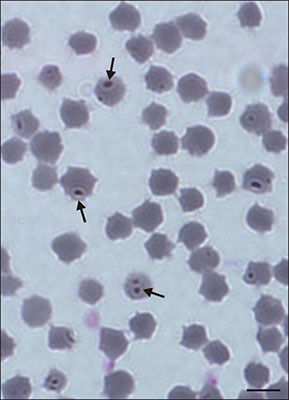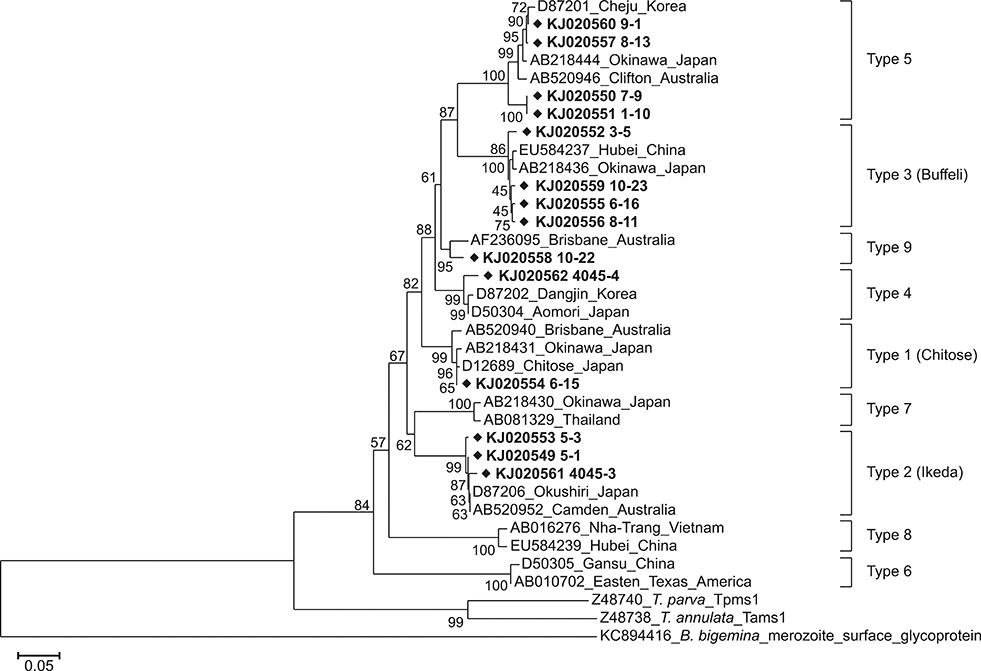J Vet Sci.
2018 Nov;19(6):846-849. 10.4142/jvs.2018.19.6.846.
Molecular phylogenetic studies on clinical bovine piroplasmosis caused by benign Theileria in Shaanxi Province, China
- Affiliations
-
- 1Department of Veterinary Pharmaceutical, Jiangsu Agri-animal Husbandry Vocational College, Taizhou 225300, China. kenhtsjj@163.com
- 2Lanzhou Institute of Husbandry and Veterinary Pharmaceutical Science, Chinese Academy of Agricultural Sciences, Key Laboratory for Veterinary Drug Innovation, Ministry of Agriculture, Lanzhou 730050, China.
- KMID: 2427034
- DOI: http://doi.org/10.4142/jvs.2018.19.6.846
Abstract
- A group of benign Theileria species, which are often referred to as T. orientalis/T. buffeli/T. sergenti group, has low pathogenicity in cattle. Herein, we report on Theileria spp. in cattle on a farm from China. Based on phylogenetic analysis of the major piroplasm surface protein gene sequences, we detected 6 genotypes that were categorized as Types 1, 2, 3, 4, and 5 as well as an additional Type 9 genotype. The new epidemiological features of the T. orientalis/T. buffeli/T. sergenti parasites in China indicate a greater diversity in the genetics of these species than had been previously thought.
Keyword
MeSH Terms
Figure
Reference
-
1. Gubbels MJ, Hong Y, van der Weide M, Qi B, Nijman IJ, Guangyuan L, Jongejan F. Molecular characterisation of the Theileria buffeli/orientalis group. Int J Parasitol. 2000; 30:943–952.2. He L, Feng HH, Zhang WJ, Zhang QL, Fang R, Wang LX, Tu P, Zhou YQ, Zhao JL, Oosthuizen MC. Occurrence of Theileria and Babesia species in water buffalo (Bubalus babalis, Linnaeus, 1758) in the Hubei province, South China. Vet Parasitol. 2012; 186:490–496.
Article3. Jeong W, Yoon SH, An DJ, Cho SH, Lee KK, Kim JY. A molecular phylogeny of the benign Theileria parasites based on major piroplasm surface protein (MPSP) gene sequences. Parasitology. 2010; 137:241–249.
Article4. Kamau J, de Vos AJ, Playford M, Salim B, Kinyanjui P, Sugimoto C. Emergence of new types of Theileria orientalis in Australian cattle and possible cause of theileriosis outbreaks. Parasit Vectors. 2011; 4:22.
Article5. Khukhuu A, Lan DT, Long PT, Ueno A, Li Y, Luo Y, Macedo AC, Matsumoto K, Inokuma H, Kawazu S, Igarashi I, Xuan X, Yokoyama N. Molecular epidemiological survey of Theileria orientalis in Thua Thien Hue province, Vietnam. J Vet Med Sci. 2011; 73:701–705.
Article6. Kim SJ, Tsuji M, Kubota S, Wei Q, Lee JM, Ishihara C, Onuma M. Sequence analysis of the major piroplasm surface protein gene of benign bovine Theileria parasites in east Asia. Int J Parasitol. 1998; 28:1219–1227.
Article7. Kubota S, Sugimoto C, Onuma M. A genetic analysis of mixed population in Theileria sergenti stocks and isolates using allele-specific polymerase chain reaction. J Vet Med Sci. 1995; 57:279–282.
Article8. Liu Q, Zhou YQ, He GS, Oosthuizen MC, Zhou DN, Zhao JL. Molecular phylogenetic studies on Theileria spp. isolates (China) based on small subunit ribosomal RNA gene sequences. Trop Anim Health Prod. 2010; 42:109–114.
Article9. McFadden AM, Rawdon TG, Meyer J, Makin J, Morley CM, Clough RR, Tham K, Mullner P, Geysen D. An outbreak of haemolytic anaemia associated with infection of Theileria orientalis in naive cattle. N Z Vet J. 2011; 59:79–85.
Article10. Ota N, Mizuno D, Kuboki N, Igarashi I, Nakamura Y, Yamashina H, Hanzaike T, Fujii K, Onoe S, Hata H, Kondo S, Matsui S, Koga M, Matsumoto K, Inokuma H, Yokoyama N. Epidemiological survey of Theileria orientalis infection in grazing cattle in the eastern part of Hokkaido, Japan. J Vet Med Sci. 2009; 71:937–944.
Article11. Rishniw M, Barr SC, Simpson KW, Frongillo MF, Franz M, Dominguez Alpizar JL. Discrimination between six species of canine microfilariae by a single polymerase chain reaction. Vet Parasitol. 2006; 135:303–314.
Article12. Shimizu S, Nojiri K, Matsunaga N, Yamane I, Minami T. Reduction in tick numbers (Haemaphysalis longicornis), mortality and incidence of Theileria sergenti infection in field-grazed calves treated with flumethrin pour-on. Vet Parasitol. 2000; 92:129–138.
Article13. Shiono H, Yagi Y, Thongnoon P, Kurabayashi N, Chikayama Y, Miyazaki S, Nakamura I. Acquired methemoglobinemia in anemic cattle infected with Theileria sergenti. Vet Parasitol. 2001; 102:45–51.
Article14. Tamura K, Peterson D, Peterson N, Stecher G, Nei M, Kumar S. MEGA5: Molecular Evolutionary Genetics Analysis using maximum likelihood, evolutionary distance, and maximum parsimony methods. Mol Biol Evol. 2011; 28:2731–2739.
Article15. Zhang S, Xu Y, Jin Y, Jin Z, Ju Y, Lu C. Development of a Bereriol slow release agent and its preventive effect against Theileriosis sergenti of cattle. Chin J Vet Sci. 1998; 18:367–369.
- Full Text Links
- Actions
-
Cited
- CITED
-
- Close
- Share
- Similar articles
-
- Molecular and serological surveillance of equine piroplasmosis in the Republic of Korea between 2016 and 2017
- Phylogenetic Analysis of Ruminant Theileria spp. from China Based on 28S Ribosomal RNA Gene
- Identical small subunit ribosomal RNA gene nucleotide sequence of bovine Theileria isolates (Korea and Japan) and Theileria buffeli (Marula, Kenya)
- Corrigendum to: Nicorandil alleviated cardiac hypoxia/reoxygenation-induced cytotoxicity via upregulating ketone body metabolism and ACAT1 activity
- Epizootiological study of theileriasis in Korea - Prevalence of the bovine theileriasis in relation to its vector, Haemaphysalis (Kaiseriana) longicornis Neumann. 1901



